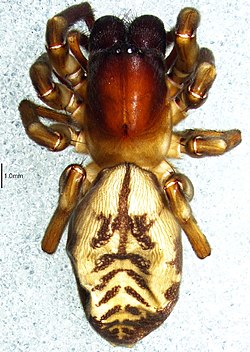| Amaurobioides | |
|---|---|
 | |
| A. maritima from New Zealand | |
 | |
| A. africana, adult female | |
| Scientific classification | |
| Kingdom: | Animalia |
| Phylum: | Arthropoda |
| Subphylum: | Chelicerata |
| Class: | Arachnida |
| Order: | Araneae |
| Infraorder: | Araneomorphae |
| Family: | Anyphaenidae |
| Genus: | Amaurobioides O. Pickard-Cambridge, 1883 [1] |
| Type species | |
| A. maritima O. Pickard-Cambridge, 1883 | |
| Species | |
12, see text | |
| Synonyms [1] | |
| |
Amaurobioides is a genus of anyphaenid sac spiders first described by O. Pickard-Cambridge in 1883. [2]
Contents
Here's a short distribution section for the genus *Amaurobioides* article: